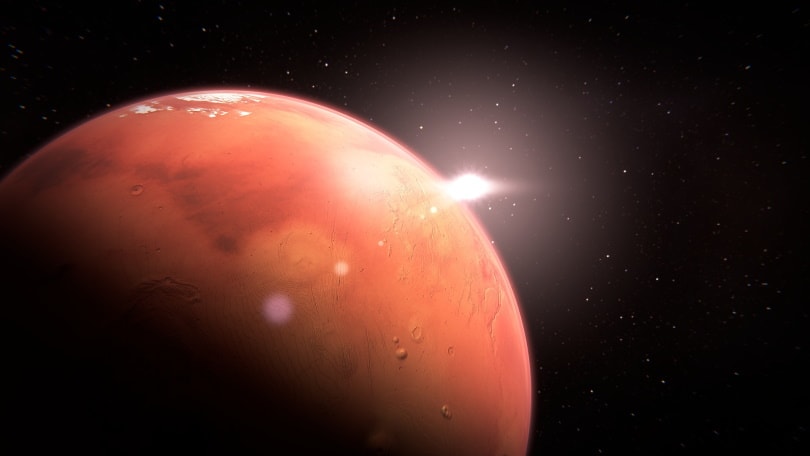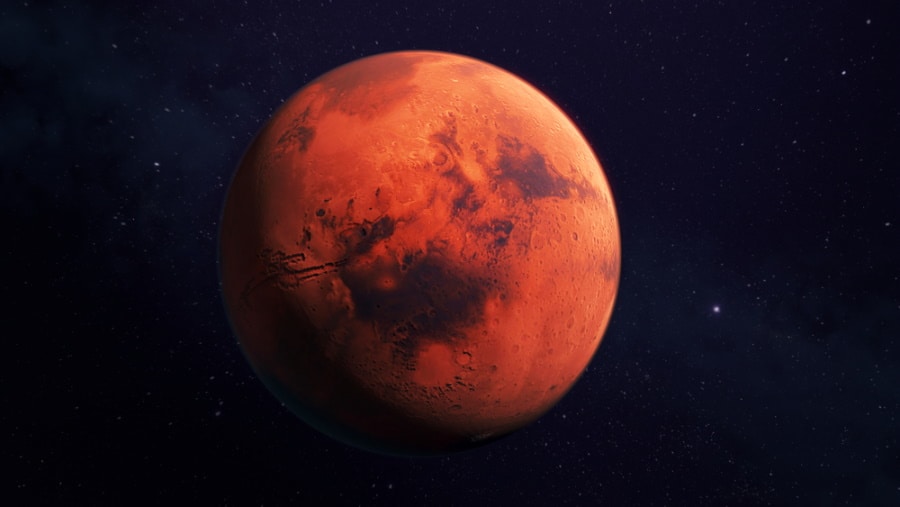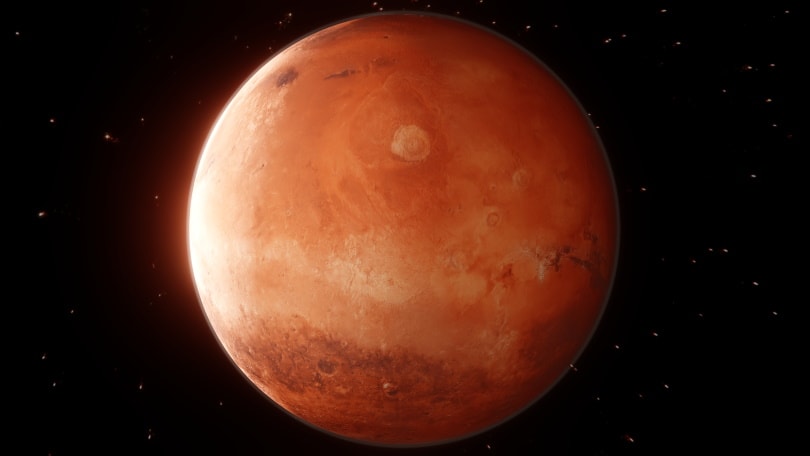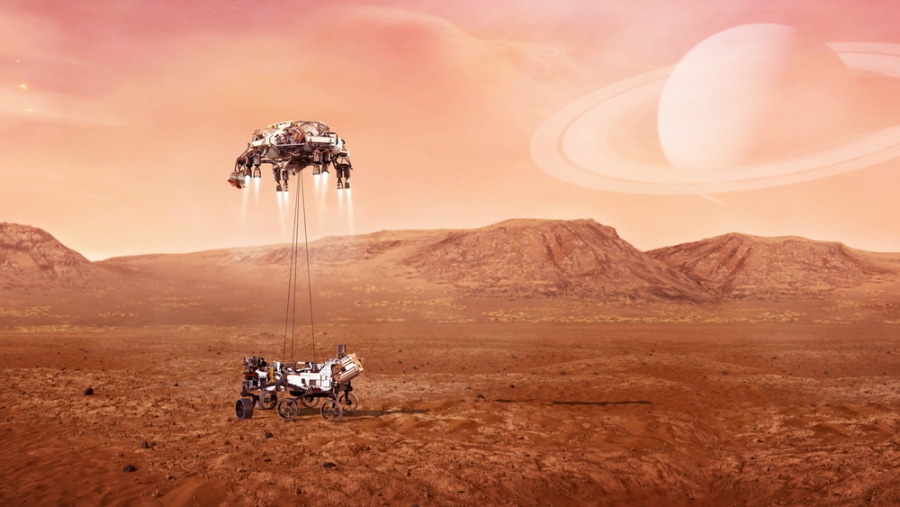Why Is Mars Red? Are There Other Colors On Mars?
Last Updated on

If you ever get the opportunity to see Mars, the first thing that you’ll take note of is its reddish tint. Anthropologists who studied the carvings on ancient Egyptian tombs discovered that they used to call it the “Her Desher,” a name that literally translates to The Red One.
But what’s the origin of that color, one may ask?
Well, as it turns out, nearly all the rocks on that planet have iron as the primary chemical component. And when you expose that element to outdoor elements such as hydrogen and oxygen, it oxidizes and turns red. In the same way steel develops rust after a while when exposed to moisture.

How did all that iron end up on Mars?
We’re not entirely sure, but there’s a theory that our scientists have been working with for a while now. Mars was created approximately 4.5 billion years ago. It was during that period that a force of unknown origin started fusing together dust, gas, debris, and several other random materials found in space to form the planet. Most of those materials were long-dead stars that were purely made of iron.
In our solar system, we only have two planets that have a lot of iron. We’ve already established Mars is one, and the other one is Earth. But while the Earth’s iron sunk to its core eons ago, that of Mars remained at the crust. Experts believe this could have been due to the fact that the gravitational pull of our planet is a lot stronger when contrasted to that of Mars.
That doesn’t mean you won’t find any iron at the core of that planet. You definitely will, but the quantity won’t be the same as at the top. Also, we’re not implying that iron by itself is red. If you’ve ever seen this material before, you already know its color ranges. It only becomes red once it’s been transformed into iron oxide—a compound commonly known as rust.
Rust has two different atoms, according to chemists. It’s a stable compound that constitutes two iron atoms, bonded to three oxygen atoms.

What precipitated Mars’ surface to oxidize?
Since these are processes that occurred billions of years ago, way before we had the technological know-how to study our solar system, we can only theorize. And several different theories try to explain this phenomenon.
One of those speculates that the oxidation was caused by flowing water. What happened to Mars is the same thing that we often observe when you leave a steel spoon in water for an extended period of time.
But Albert Yen, one of the astronomers who worked with NASA, got the opportunity to study the data collected by the 1997 Pathfinder Mission. He believed all that iron oxide came from meteorites.
Danish researchers wanted a piece of the action, so they decided to conduct their own study. In the end, they found out that you don’t need water to oxidize iron. They also discovered that oxygen-rich surfaces are often left exposed once quartz crystals disintegrate. And these minerals are always present in that planet’s regolith.
Their assumption is, that there was a storm that caused the quartz crystals to crumble, and that precipitated the process. The sun’s light obviously acted as a catalyst, as it has the potential to break down carbon dioxide and other molecules, to produce new oxidants.

Does that mean you won’t find any other color on Mars?
That’s the same as asking if it’s impossible to find any other color on Earth, seeing as it’s often referred to as the “Blue Marble.” And yes, our planet usually appears blue from a distance, chiefly because it’s covered by a thick atmosphere and vast water bodies.
Thanks to our rovers, we now know Mars is not entirely red. We have regions that are black and those that are brown. We’ve also drilled a couple of inches below the surface and discovered that the subsurface is brown.
What color is Mars’ sky?
The sky on Mars is red due to the dust particles that litter its atmosphere. But to understand how they influence the Martian sky’s color, you’ll have to acquaint yourself with the Rayleigh Scattering concept. It’s the dispersion of light by molecules that have a radius that’s about a tenth of the light’s wavelength. When the sun’s light hits those particles, they end up spreading red photons that make the sky appear red.

Who discovered Mars?
We don’t know who deserves the credit because this planet has been observed by so many people for so many years. The Chinese have records of astronomers who studied it even before the establishment of the Zhou Dynasty and the Egyptians had people already researching it in the 2nd millennium BCE.
We know that Galileo Galilei was the first person to observe it using a telescope. He was an engineer, a physicist, and an astronomer who also discovered Jupiter’s moons, the different phases of Venus, and the mountains and craters on the moon.
Is Mars hot or cold?
The temperatures on Mars are so low that they cannot sustain human life. Those chilly temperatures could be caused by one of two things: if it’s not the distance between the planet and the sun, it has to be its atmosphere. Compared to what we have here, that atmosphere doesn’t have what it takes to hold onto the heat. It’s just too weak.


Conclusion
The color of Mars is more than what meets the eye. From a distance, the whole planet will look red. But as you approach it, you start to realize some regions are black, while others are brown. Also, the redness is a result of iron being oxidized. Several theories have tried to explain how or why that happened, but no one is certain.
Featured Image Credit By Colin Behrens, Pixabay
About the Author Robert Sparks
Robert’s obsession with all things optical started early in life, when his optician father would bring home prototypes for Robert to play with. Nowadays, Robert is dedicated to helping others find the right optics for their needs. His hobbies include astronomy, astrophysics, and model building. Originally from Newark, NJ, he resides in Santa Fe, New Mexico, where the nighttime skies are filled with glittering stars.
Related Articles:
Binocular Magnification Chart: Numbers & Distances Compared
What Is the Best Binocular Magnification for Hunting? Optical Features Explained
How to Clean a Refractor Telescope: Step-by-Step Guide
How to Clean a Telescope Eyepiece: Step-by-Step Guide
How to Clean a Rifle Scope: 8 Expert Tips
Monocular vs Telescope: Differences Explained (With Pictures)
What Is a Monocular Used For? 8 Common Functions
How to Clean a Telescope Mirror: 8 Expert Tips
